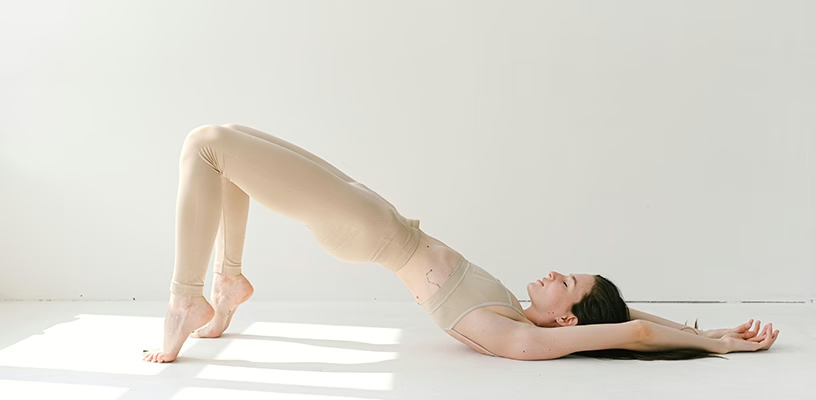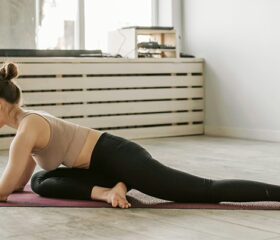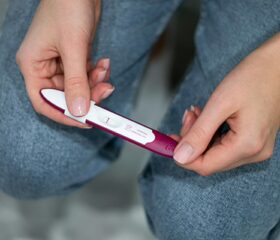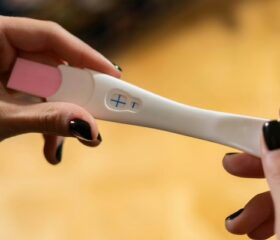7 Best Exercises to Treat Diastasis Recti After Pregnancy
After bringing your beautiful baby home from the hospital, you might find that you returned with an extra (uninvited) guest—a little pooch around your midsection known as diastasis recti.

- What is diastasis recti?
- What are the risk factors for diastasis recti?
- How can exercise help you recover from diastasis recti?
- Basic exercises for correcting diastasis recti
- Advanced exercises for correcting diastasis recti
- Exercises to avoid when you have diastasis recti
- When is it safe to start exercising?
- Other treatment options when you have diastasis recti
- Final thoughts
Although celebrities seem to shrink back into their pre-pregnancy bodies instantly, the truth is that it’s completely natural for your body to look differently than it did before. You might start to notice little “flaws” that everybody seems to have magical cures for—stretch marks, loose skin, wider hips, and so on.
Some of those changes are superficial and you should do your best not to worry about them. However, others can impact your physical wellbeing. Diastasis recti is one of these; it can affect your posture, core strength, and lower back. 1
Read on to learn what this condition is, what causes it, and what you can do to fix it.
What is diastasis recti?
Diastasis recti is when the two front muscles in your abdomen (your “rectus muscles”) stretch and move apart, leaving a gap down your midline. 1
This abdominal separation helps your body make room for your baby to grow, which means that all women go through this, not just you.
After you give birth, these muscles are supposed to grow back together. However, if you still see a “doming” or cone shape in your stomach when you’re sitting up in bed or leaning back, you might be one of the 60% of women who still experience this abdominal separation postpartum. 2
Diastasis recti usually resolves on its own in the weeks after childbirth, but still affects around 40% of women by the six-month mark. 3 4 It’s important to give yourself some grace; “bouncing back” instantly after childbirth may be the expectation, but it isn’t the norm.
How to check for diastasis recti at home
While you should always seek a professional diagnosis from your healthcare providers, here’s a simple self-test you can do for diastasis recti at home:
- First, lie on your back with your knees bent and your feet flat on the floor.
- Then, raise your head and shoulders as if you’re doing a small crunch.
- Use your fingers to feel around the middle of your stomach, slightly above and below your belly button.
- If you feel a gap there that has a slight bouncy resistance, that’s your abdominal muscle separation.
- You can assess the width of the gap by pressing your hand flat against your stomach and seeing how many fingers you can fit in the space there.
If you can fit fewer than 1½ fingers in there, your abdominal separation is relatively minor, meaning it will probably close on its own. If you can fit several fingers, you have a more severe case, but one you may be able to improve with certain exercises.
If you can fit 3–5 fingers, your diastasis recti may require surgical intervention, although you’ll need to see a doctor to confirm that for sure. 5
Other symptoms of diastasis recti
If you’re still unsure whether you have diastasis recti, try checking for these accompanying symptoms: 6
- Constipation
- Lower back pain
- Pelvic or hip pain
- Reduced mobility
- Difficulty lifting heavy objects
- Urine leaking when you cough or sneeze
- Pain when you have sex after childbirth
What are the risk factors for diastasis recti?
You’re more likely to develop diastasis recti if you:
How can exercise help you recover from diastasis recti?
Here comes even more exercise after that months-long marathon you just ran. This type of abdominal separation doesn’t always resolve on its own, but it’s sometimes possible to use targeted exercises to help push your muscles back together.
Note that you should only do the following exercises under the guidance of a physical therapist. This article will give you an idea of what they might have you work on, but don’t attempt to do them at home—talk to your doctor before starting any new exercise regimen in the postpartum period.
Your therapist will probably have you focus on strengthening the transverse abdominis (TVA), which is the deepest of your abdominal muscles. A strong TVA can help draw the separated muscles together while supporting your spine and pelvis.
Basic exercises for correcting diastasis recti
If you want to strengthen your core and treat your diastasis recti, try these exercises:
1. Diaphragmatic breathing with kegels
To start, find a position that’s comfortable for you—either sitting up straight, standing, or lying down with your knees bent. You can place a pillow under your head if needed. Then:
- Place one hand on your stomach and the other on your chest, breathing in deeply through your nose for a few seconds. The hand on your stomach should rise as you inhale, but the one on your chest should remain still.
- As you exhale through your mouth, let your stomach relax while performing a Kegel contraction, drawing your pelvic floor up (try imagining that you’re holding in your pee).
- As you continue exhaling, squeeze your abdominal muscles up and inwards toward your spine.
Perform this exercise for about ten slow breaths.
Note: Doing Kegel exercises is only a good idea if you have no preexisting pelvic floor dysfunction issues, such as hypertonic pelvic floor.
Again, it’s best to do all of the diastasis recti exercises after getting them approved by your doctor (and under the supervision of a physical therapist) in case you do have any issues that make some of these workouts potentially problematic.
2. Pelvic tilts (hands and knees)
For this exercise, you’ll need to get on your hands and knees, placing your hands directly under your shoulders and placing your knees hip-width apart. You can use a yoga mat or a soft rug if the floor is too hard. Next:
- Take a deep breath, making sure the air inflates your ribcage as much as possible without being uncomfortable.
- As you exhale, tuck your tailbone down and under you, curling your spine.
- Breathe in again, going back to a relaxed position.
Do ten slow repetitions, arching and flattening your lower back (not your whole spine). Note that you should be engaging your abs, not your glutes.
3. Kneeling leg and arm extensions with knee taps
To do this exercise, start on your hands and knees again, engaging your core muscles and drawing them up toward your spine. Then:
- Stretch your right arm forward and your left leg back. As you do, inhale, keeping your core clenched.
- Exhale while bringing your right arm and left leg toward each other, tapping your elbow against your knee.
- Inhale, stretching both limbs out again before returning to your beginning position.
Alternate between left-right and right-left combos and complete ten reps on each side.
4. Toe taps (lying on your back)
For this exercise, you’ll need to lie flat on your back. The good news is that you don’t even need to leave your bed (yay!), although you can also do this on the floor.
- Lift your legs in the air and bend your knees at 90 degrees, right above your hips. This is called the tabletop position.
- Make sure that your head, shoulders and back are relaxed, leaving a slight gap between your lower back and the floor or bed.
- Breathe deeply, filling your ribcage.
- Exhale, tapping your right foot down to the floor or mattress and engaging your core muscles.
- Keep your pelvis stable, making sure that your hips don’t shift with the movement of your leg.
- Inhale, returning to the tabletop position.
- Do the same with your left leg.
Repeat ten reps on each side.
If you’re having trouble with this exercise, it’s okay to change the angle of your knees from the 90 degree position. The closer you keep your knees to your chest, the easier the exercise will be. Conversely, the farther your knees are, the harder it will be. Experiment to see what works best for you.
Advanced exercises for correcting diastasis recti
Let’s explore a few more (advanced) core exercises that support your recovery without straining your abdominals:
5. Single leg reaches (lying on your back)
When you do this, you’ll lie down in the tabletop position again (with your legs lifted and your knees bent at 90 degrees).
- Stretch your right leg out at a diagonal angle, keeping your hips stable so they don’t move.
- As you inhale, move your leg back to the tabletop position.
- Do the same with your left leg.
Complete ten reps on each side.
This exercise is effective for developing your core stability. You should focus on slow, controlled movements while keeping your back steady—no arching allowed.
6. Single leg extensions with weights (optional)
This is another exercise you can do while on your back without leaving the bed. You’ll want to start by keeping your feet flat on the ground, hip-width apart. Next:
- Take a deep breath and lift your right leg up into the tabletop position, with your arms stretched out on either side of your knee.
- Extend your right leg out at a high angle as you exhale while straightening your arms out behind you.
- Keep your back in a neutral position, making sure you don’t arch off the floor or bed.
- As you inhale, pull your leg back to the tabletop position, ensuring your back remains flat.
Do ten reps on each side.
Once you feel comfortable enough with your form and stability, consider adding weights to this exercise for increased difficulty. You can start with holding light dumbbells (about 1–2 lb) in each hand and add more weight as you progress.
Double leg extensions (advanced)
Once you master the single leg extension, you can try the same exercise with both legs instead of one. Remember to keep your back in a neutral position while engaging your core.
If you’re having difficulty performing the exercise while keeping your core flat without the doming or bulging of your abdominal muscles, it’s okay to go back to the single leg extension and try to work your way back up to this exercise later.
7. C-curves
For this last exercise, you’ll need to find a comfortable place to sit up straight, keeping your legs hip-width apart, with your knees bent and your feet flat on the floor. Next:
- Tuck your hands under your knees, keeping your elbows pointed out toward the sides.
- As you inhale, engage your core muscles, pulling your abdominal muscles inwards.
- Exhale, hollowing out your stomach while pressing your lower back towards the floor.
- Your back should form the letter C as you tuck your pelvis under you, and your shoulders should be slightly above the line of your knees.
- Your elbows should remain angled outward and your chest should be “open” (your muscles shouldn’t fold inward).
- Hold that position for a moment as you breathe in and out again for three breaths, tightening and relaxing your abdominals.
To make this exercise easier, you can make your C-curve higher by not pressing your back so low to the floor.
If your stomach bulges, return to your starting position and focus on keeping your abdominal muscles engaged but flat, pulling them into your spine.
Exercises to avoid when you have diastasis recti
Believe it or not, some workouts can actually worsen abdominal separation. While you’re healing, you should avoid most traditional ab exercises, including crunches, planks, push-ups, and sit-ups. 10
Here are other exercises to steer clear of—at least until you’ve made significant progress in healing:
- High-pressure exercises: Avoid any exercise that increases inner abdominal pressure beyond your ability to manage it, such as heavy lifting, especially with improper form.
- High-impact or fast-paced exercises: Steer clear of dynamic movements that are difficult to control and assess for proper form, like burpees or high knees.
- Exercises that cause doming or bulging: The same goes for exercises where you can see your stomach bulging, like jump squats.
- Spinal extension: Lastly, movements that put stress on the spine and abdominal tissues, like backbends, can be similarly dangerous.
As mentioned, one common symptom of diastasis recti is your urine leaking due to your weakened core. If you experience any accidents while performing these moves, you should consider moving on to a different exercise.
When is it safe to start exercising?
While no two pregnancies are alike, it’s usually safe to start moving around again a few days after you give birth—provided you didn’t have any major labor complications, such as a C-section.
Limit yourself to walking on a flat surface. Avoid doing anything involving stretches or pelvic floor exercises until you get the all-clear from your doctor. They’ll probably approve more strenuous exercise by the six-week mark. 11
Other treatment options when you have diastasis recti
While exercise is the go-to treatment method for many women, there are other ways of dealing with postpartum abdominal separation. These include:
- Abdominal binders: If you need a little help speeding up the healing process, consider using postpartum belly bands. When used correctly, these can help to close the gap between your abdominal muscles while providing support to your pelvic floor. 12
- Physical therapy: If you’re having a tough time recovering, you should consider seeing a physical therapist, preferably one who specializes in diastasis recti. Your healthcare providers might be able to give you a referral, or you can search online or through clinics in your area for physical therapists certified in postpartum rehabilitation.
- Surgery: If exercises and physical therapy just aren’t cutting it, then surgery might be necessary to treat your diastasis recti. Surgical intervention usually involves a laparoscopic procedure (sometimes called a keyhole or minimally invasive procedure) to help reattach the separated muscles. If there’s excess skin or fat after your procedure, you might also undergo an abdominoplasty (tummy tuck).
Final thoughts
It seems like everywhere you look, there’s another video or article telling you how to snap back into shape after childbirth—as if you didn’t just spend months creating life! It can be frustrating to feel as if you’re not reaching your postpartum body goals, but it’s important to give your body time to recover after childbirth.
Remember that your recovery journey is unique to you and that you should prioritize your health over all else. Now, take a deep breath. You’ve got this, one ab workout at a time.
Article Sources
- Penn Medicine. "News and views" Retrieved August 1, 2025.
- Hospital for Special Surgery. "Diastasis Recti: What It Is and How to Fix It" Retrieved August 1, 2025.
- The Ohio State University. "What’s the difference between 'mommy tummy' and diastasis recti?" Retrieved August 1, 2025.
- Island Health. "Diastasis: What every new mother needs to know about abdominal separation" Retrieved August 1, 2025.
- ACE Physical Therapy and Sports Medicine Institute. "Diastatis Recti and the Postpartum Stomach Pooch" Retrieved August 1, 2025.
- Sanford Health. "Get the facts about a common post-pregnancy body change" Retrieved August 1, 2025.
- Virtua Health. "The Post Pregnancy Belly Bulge You Should Be Concerned About" Retrieved August 1, 2025.
- Cleveland Clinic. "Diastasis Recti" Retrieved August 1, 2025.
- MedlinePlus. "Diastasis recti" Retrieved August 1, 2025.
- UNM Health. "Exercise After Pregnancy: When to Start and What to Do" Retrieved August 1, 2025.
- National Health Service. "Keeping fit and healthy with a baby" Retrieved August 1, 2025.
- Healthline. "Why belly binding is effective for postpartum recovery" Retrieved August 1, 2025.







